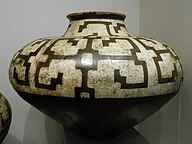This is an old revision of this page, as edited by Agusbou2015 (talk | contribs) at 01:25, 26 January 2018 (Typo fixing, typo(s) fixed: consiousness → consciousness using AWB). The present address (URL) is a permanent link to this revision, which may differ significantly from the current revision.
Revision as of 01:25, 26 January 2018 by Agusbou2015 (talk | contribs) (Typo fixing, typo(s) fixed: consiousness → consciousness using AWB)(diff) ← Previous revision | Latest revision (diff) | Newer revision → (diff)| This article needs additional citations for verification. Please help improve this article by adding citations to reliable sources. Unsourced material may be challenged and removed. Find sources: "Icaro" – news · newspapers · books · scholar · JSTOR (April 2016) (Learn how and when to remove this message) |

Icaro (Template:Lang-qu) is a South American indigenous colloquialism for magic or alchemy, or any esoteric modality by which an experienced user can channel their energy to manifest their will. Today, this term is commonly used to describe the medicine songs performed in vegetal ceremonies, especially by shamans in ayahuasca ceremonies to induce a profound state of healing, awareness or amazement. It is also commonly used to describe a traditional artisanal pattern of the Shipibo tribe based on the visions induced by ayahuasca.
Original Meaning
The word icaro is believed to derive from the Quechua verb ikaray, which means "to blow smoke in order to heal".
In the book The Witchdoctor's Apprentice, pioneering botanist Nicole Maxwell accounts her experience among the first to trek through the Peruvian Amazon rainforest seeking ancient medicines from indigenous tribes. She commonly encounters tribes using the word "icaro" to describe the seemingly supernatural powers of shamans or witch doctors to evoke their will. Usually, this term was used by the natives to describe instances of dark magic, such as the means by which brujos would summon jungle predators or illnesses to kill their enemies, but it has also been used to describe positive things, like the knowledge of medicinal spells, formulas and plants.
Healing Ceremonies
Medicine Songs

Icaro is most commonly used to describe the medicine songs used by shamans in healing ceremonies, such as with the psychedelic brew ayahuasca. Traditionally, these songs can be performed by whistling, singing with the voice or vocables, or playing an instrument such as the didgeridoo or flute, and usually involve a mastery of advanced techniques to evoke the healing effects. As shamanic practices evolve alongside modern society and culture, so too do the icaros. Today, they might be performed by the shaman alone, by the group of participants, by a live acoustic ensemble or disk jockey, or by any combination of these.
Traditionally, icaros may come to a shaman during a ceremony, be passed down from previous lineages of healers, or come to a shaman during a 'dieta' where plant spirits teach icaros to the shaman directly. The singing or whistling of icaros is sometimes accompanied by a chakapa, a rattle of bundled leaves. Due to the complexity of certain performance techniques, it may take many years to learn certain icaros, and experienced shamans may be able to recite hundreds of them.
Functionally, icaros are used to enhance or subdue the effects of plant medicines, to evoke plant spirits, to invite the spirits of others or the deceased, to dispel dark spirits, or to protect those present, and to manage the ceremony.
Other Healing Practices
Sometimes, "icaros" may be used to describe the other ritualistic actions taken by a healer during a ceremony for the sake of affecting consciousness.
In ayahuasca ceremonies of Iquitos, Peru, you may find any of the following are considered an icaro:
- Shaking a chakapa at a consistent tempo
- Shaking a chakapa in different corners of the room
- Blowing mapacho smoke
- Mouth-made sound effects of wind or fast-moving air
- Purging sounds and mannerisms
- Invitations of spirits or forces
- Hypnotic speaking

Shipibo Artisanal Patterns
Icaro is also a modern colloquialism used to describe a pattern common in the artifacts and artisanal goods made by the Shipibo people .
These patterns, usually involving geometric shapes and contrasting colors, are said to be based on the visions induced by ayahuasca. Scientifically, these visions have been identified as an effect of DMT, the active hallucinogenic compound in the brew.
In the art and clothing of the Shipibo-Konibo people of Western Peru, geometric designs called kené, which are said to represent vibrations, are used as decoration. Kené are generally employed by women, and come to artists in the same manner as icaros: from other artists, during plant medicine ceremonies, as part of a 'dieta', in dreams and in trance states.
Neoshamanism

In modern times, the domain of the shaman has split into many social roles or careers: most notably are the doctor, the priest, and the artist. From a neoshamanic perspective, the modern form of "icaro" may describe anything from pharmaceuticals to MRI machines, sacrements to holy books, and printers to subwoofers . This is because all of these tools are used to manifest the will of the shaman and can, with the necessary skill, be used to modify consciousness and reality.
In Music
Today, musicians, bands and DJs, most notably at music festivals, bear a close resemblance to shamans performing music during medicinal ceremonies. Music festivals are the most common place for people to ingest psychedelic medicines, and performers commonly design their songs and musical experiences to be immersive, and in many cases, healing. In this sense, modern musical icaros are performed using everything between acoustic instruments, microphones, amplifiers, MIDI keyboards, DJ decks, light or laser shows and projections.
Visionary Art
The visionary art movement may be considered a modern equivalent of the Shipibo artisanal icaro patterns or "kené", as its works often attempt to portray the visions of transcendent states induced by psychedelic experiences.
References
- ^ Nicole., Maxwell, (1990-01-01). Witch doctor's apprentice : hunting for medicinal plants in the Amazon. MJF Books. ISBN 1567313035. OCLC 42683849.
{{cite book}}: CS1 maint: extra punctuation (link) CS1 maint: multiple names: authors list (link) - Pratt, Christina (2007). Ency of Shamanism. The Rosen Publishing Group. p. 220.
- Luna, Luis Eduardo (1986). Vegetalismo (Stockholm Studies in Comparative Religion). Almqvist & Wiksell Internat. ISBN 91-22-00819-5.
- ^ Haule, John Ryan (2011). Jung in the 21st Century: Synchronicity and science. Taylor & Francis. pp. 47–48.
- Beyer, Stephan V. (2009). Singing to the Plants: A Guide to Mestizo Shamanism in the Upper Amazon. Albuquerque: University of New Mexico Press. ISBN 978-0-8263-4729-9.
some songs, such as calling in the spirit of ayahuasca at the start of a ceremony, are performed without rhytmic accompaniment, while healings are all performed with the shacapa.
- Rozendal, Keith. "Meet Mother Ayahuasca". Retrieved 21 August 2012.